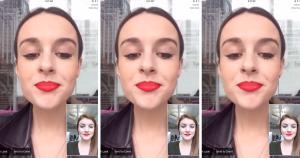Last year the beauty industry had an estimated worth of $445 million and that figure is set to only increase in the coming years. Following the numerous closures of many well known and loved high street brands, it’s a wonder as to how the beauty industry is continuing to drive profit and reap the rewards of an increasingly unstable economic climate. Similarly, the global apparel market is estimated to be worth $2.7 trillion and is expected to grow to $285 billion in the USA and $440 billion in the EU. This poses the question as to what are these two huge sectors going to do in order to stay relevant and profitable? To find out the answer, all we need do is open our eyes.
In 2015 global powerhouse and makeup giant L’Oreal launched its Make-up Genius app, which works by using the front facing camera on smartphones and facial mapping technology to test virtual looks on a person’s face. The augmented reality app allowed users to try out thousands of L’Oreal’s products in real time by mapping 64 facial points so that the virtual makeup could be seen at any angle as the user tilts their head. As one of the first tests in the field of augmented reality by a member of the beauty industry, the app was a huge step towards what we now know as phygital - the blending of digital experiences with physical ones.
Since then, we’ve seen more and more brands adopting a phygital approach in helping to drive sales. The French beauty brand Sephora launched a digitalised-concept store last year in attempts to forge stronger relationships with their customers. The Sephora Experience Stores featured a Beauty Hub: a heavily digital influenced counter where customers are encouraged to try out new products, learn from makeup artists and discover new looks via a range of new technologies such as iPad stations. There were also Skin Patch stations to help customers find their perfect shade match.
In fashion, we’ve seen Marks & Spencer try out virtual wardrobe concepts and more recently, Harvey Nichols have partnered with global tech company Hero to test out an online stylist function. The new feature will allow customers to connect with in-store stylists to receive style tips and find out more information about products. This phygital feature has been employed to help the department store boost sales and give customers an in-store experience when shopping online. Harvey Nichols’ executive director Pearson Poon has stated that during the trial period of the online stylist platform, customers were “five times more likely to purchase a product and likely to spend twice as much.” See it in action here.
Cut to present day and L’Oreal have propelled themselves even further ahead in the field of phygital advancement by announcing plans to roll out a digital beauty assistant. L’Oreal want to invest in augmented reality and livestreaming technologies to give customers a digital beauty assistant who will help users test products out digitally, recommending them products and colour suggestions. Customers will then be able to buy the suggested products and book livestreaming consultation sessions with beauty experts to learn how to use said products. The digital beauty assistant aims to strengthen customer relations and to give them a personalised makeup counter experience from the comfort of their own home. And with the growth of shopping at home, in the office and on the train, it's no wonder that these at-your-fingertips technologies are booming.

Image source:The Drum/Lubomira RochetIt’s clear that brands are going to have to adapt to our new digital era in order to stay successful and relevant. This is evident through the trends that are populating our Instagram feeds such as bespoke beauty, Instabait packaging, the promotion of gender fluidity and direct-to-consumer marketing. Most of these techniques wouldn’t have existed ten years ago but now more brands are relying on these methods to increase promotion and drive sales. As well as these trends, companies are investing large amounts in order to integrate their services with the world of technology. Even established brands owe it to the consumer to reach them where they shop, adapting marketing with digital innovations to provide clarity that navigates a new online landscape. The saying “the measure of intelligence is the ability to change,” is no more relevant than now as brands are expected to keep up with the phygital revolution to remain visible in the consumer world. Whilst adapting to the technological environment grows increasingly popular, the competitiveness of the industry is overshadowed by undeniable sales potential.
The phygital race is undoubtedly underway as companies strive to be ahead of the field in adopting phygital concepts, which leaves us to question: what will be the next step in improving user experience in the beauty and fashion industries? And who will be driving that step - your brand or someone else's?
Image Credits: The Drum